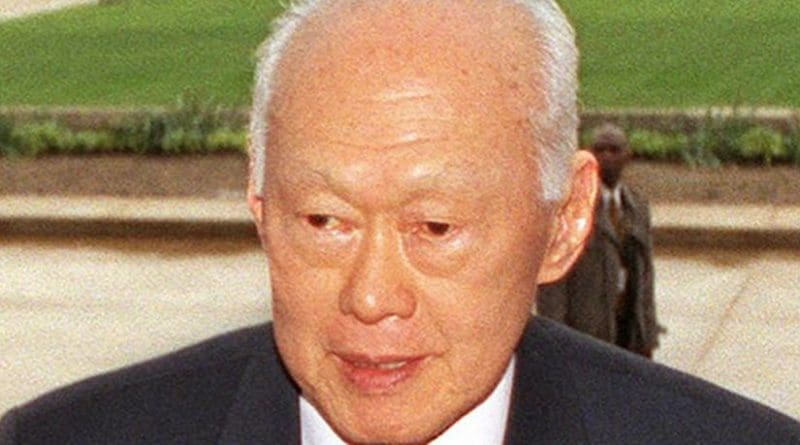Lee Kuan Yew: A Towering Inspiration For China – Analysis
By Zha Daojiong*
A legendary tale has it that Deng Xiaoping was so astonished by the changes he witnessed on his visit to Singapore in November 1978 that he made up his mind about opening and reforming China by learning from Singapore. In his youth, Deng had once made a stopover in Singapore on his trip to France. The visual contrast could not have been stronger. Lee Kuan Yew was the founding father of Singapore, and made possible his country’s transformation.
Two years prior, Lee had already travelled to China, in spite of the absence of formal diplomatic ties between the two countries. In his lifetime, Lee made 33 trips to China, each personalizing his own commitment to being a positive contribution to China’s pursuit of modernization.
A Source of Inspiration
Lee Kuan Yew built a country – small in geographical size and with virtually no material resources within its boundaries to use beyond sustaining sheer human survival – into one to be respected not only throughout Southeast Asia, but also worldwide. If anything, the country Lee Kuan Yew led and supervised in governing proved its continuous resilience throughout the decades of profound challenges in its neighborhood and beyond.
Partly owing to the fact that ethnic Chinese are the majority in the Singaporean society, many of whom – Lee’s own family included – had migrated to that part of the Malay peninsula when China was the “sick man of Asia,” Singapore’s record of rising from the ashes serves as a source of inspiration: as a people the Chinese can prevail out of adverse circumstances, just like other peoples of the world. It is up to the Chinese in China to prove that they too can match their achievements with those of their Singaporean cousins by kinship and cultural ties.
Today, the catch phrase for that inspiration is “soft power.” Singapore is beyond dispute one of the few of countries that truly attracted China, its government and populace. It was only natural for the Chinese government to choose Singapore to be one of the first destinations for Chinese citizens to go on private foreign travel, in the beginning years of the 1990s. Singapore was not just a place with a large Chinese speaking community, but visibly a successful country. The more average Chinese could learn from Singapore, the better they could contribute to improving China.
A Teacher of Governance
Lee Kuan Yew gave priority to maintenance of social and political stability in governing his country. Among other points of wisdom in him as a national leader, the necessity of stability in governance resonated more closely in China.
As a matter of fact, compatibility in governance approaches led China to seek Singapore’s assistance in training Chinese civil servants. Such training programs cover a wide-ranging set of topics, from economic policy to project management, from community management to fighting against corruption; virtually every aspect of governance was covered in these programs. Transfer of ideational/technical expertise from Singapore to China has become systematic.
For China, learning from Singapore comes with a unique cultural environment. Under Lee Kuan Yew’s leadership and personal exemplification, civil servants of Singapore are required to be fluent in the Chinese language. This greatly helps enabling Chinese participants to benefit from interactions outside the formal classroom, an attribute unavailable in many other advanced economies.
In the wider world, the match in governance between Singapore and China has received mixed commentary, including some critical. But Lee Kuan Yew and his successors stood the ground and, arguably, have prevailed. China is solely responsible for shortcomings still existent in its own society. The appeal of building a clean government, with Mr. Lee as a leader and his country as a model, continues to be strong.
Singapore in China
In April 1994, Lee Kuan Yew (as Senior Minister) inaugurated the China-Suzhou Industrial Park, in China’s Jiangsu province. For China, this “Singapore in China” project was conceived to be a tangible demonstration of modernization. Chinese planners envisioned 2012 to be the year for the collaborative Suzhou project to reach comparable Human Development Index levels of Singapore in 2011.
The initial years of Suzhou project did not live up to Singaporean expectations. It was the fundamentals in bilateral relationship Lee Kuan Yew had built up that helped it to continue. Emphasis on pragmatism, another hallmark of Lee Kuan Yew’s leadership, helps to navigate both sides of the partnership.
Today, ‘Singapore in China’ projects have spread to cities including Tianjin, Guangzhou, and Shenyang. In numerous other Chinese industrial zones and beyond, Singaporean presence is strong. The value of these projects goes beyond statistical records of trade and investment. Throughout the times of uncertainty the outside world had about China as a global economic partner, Lee Kuan Yew and his government cast a vote of confidence.
The one thing Lee Kuan Yew has for sure shown China and the Chinese society is that countries do not have to be large and strong in the conventional sense of the term to be valuable. Mr. Lee is going to be remembered as a true towering source of inspiration.
This article appeared at China-US Focus

